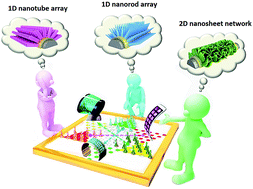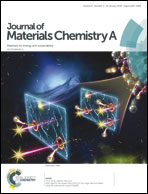From 1D nanotube arrays to 2D nanosheet networks on silver-coated textiles: new insights into the factors determining the performance of a core–shell hierarchical structure for wearable supercapacitors†
Abstract
A “core–shell” hierarchical architecture is highly efficient for enhancing the performance of flexible electrodes for wearable energy storage devices. Thus it is important to clarify the correlation between the properties of flexible electrodes, including the electrochemical kinetics, structure stability, mechanical properties, flexibility, etc., and the microstructure of the “core–shell” architectures. Herein, new insights into the factors that determine the performance of the core–shell hierarchical structured electrodes based on a silver-coated textile and nanostructured active materials are obtained. A comprehensive study is conducted using a variety of active materials, including metal hydroxides (e.g. Ni(OH)2, Ni–Co layered double hydroxide (LDH)), hydrates (e.g. NiMoO4 hydrate), and sulfides (e.g. Ni(Fe)Co2S4) with three typical nanostructures of a 1D nanotube array, a 1D nanorod array, and a 2D nanosheet network. The silver coating is produced by in situ electroless deposition. It not only promotes the electronic conductivity of the textile, but also strengthens the connections between the active materials and the textile fibers. When the flexible electrode is nearly flat, the 1D nanotube array-based hierarchical structure achieves the best high rate capability because of its high surface area, but the performance is degraded under high-degree and high-frequency deformations. In contrast, the 2D nanosheet network-based structure can endure severe deformation due to its excellent structure stability, but the interconnected architecture diminishes the contact area between the active material and electrolytes. Moreover, the all-solid-state flexible supercapacitors with the Ni–Co LDH nanosheet network electrode have excellent cycling properties (up to 10 000 cycles) and high tolerance to repeated high-degree bending, and those with the metal sulfide nanotube array-based electrode display a superior high rate capability when the supercapacitor is nearly flat. The distinct advantages of different “core–shell” hierarchical architectures make them suitable for different practical applications. Therefore, this work not only provides a comprehensive understanding on various “core–shell” hierarchical structures, but also provides some critical clues to the optimization of wearable supercapacitors for extended applications.



 Please wait while we load your content...
Please wait while we load your content...